| Monday did not bode well from the weather forecast and it
certainly lived up to expectations. Forecasts in the east talk about a 20%
chance of rain (sorry, precipitation) at the first hint of humidity. Here a 20% chance is a dead
certainty. And at 8000 ft that can mean snow - even in June. And so it was
to be. We decided that our trips on the scooter in the last couple of days
had been too cold and everywhere is too far apart for the limited range we
have. So we took the RV to Mammoth Hot Springs in the north western corner.
And on the way, it snowed - and it settled! |  |
 |
However by the time we arrived, (it is some 50 miles from Fishing Bridge
where we were camped) it had just about stopped raining. The thermal springs are
above Mammoth Hot Springs which is where the army used to be based when it
managed the park in the days before the Parks Service existed. The actual
position of the springs and fumaroles is constantly changing and as they
become dormant the landscape becomes lunar in nature. Although it is
surprising what vegetation does still exist close by (I'm not sure about thrive...).
This is the view of the main terrace. |
| The first big spring we visited was Canary Spring. The waters
reaching the surface are quite hot and contain significant amounts of
minerals (predominantly calcium carbonate) which they deposit as they flow.
In the warmer bits various forms of algae and bacteria and other organisms
live which can lead to some awesome colours. Unfortunately most of these are
hidden by the constant swirls of steam rising from the hot water. (Water at
these altitudes boils at 199°F.) |
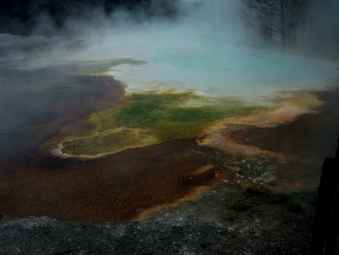 |
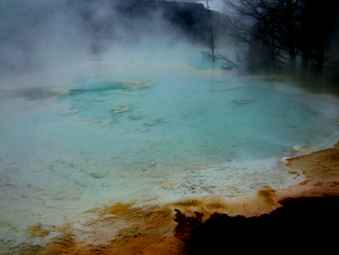 |
But the bubbling blue water of the primary pond was an amazing colour, even
if you couldn't see it often. You can also see the different coloured algae
around the edges. |
| As the water leaves the pond and cools, it deposits minerals at
the edges, these form little walls so you end up with cascades. The
impurities in the minerals give rise to variations in colour so the whole
effect is quite awesome. | 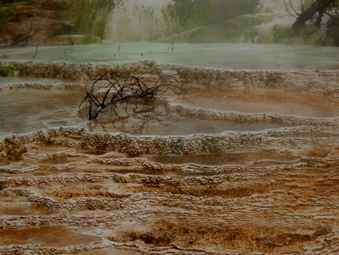 |
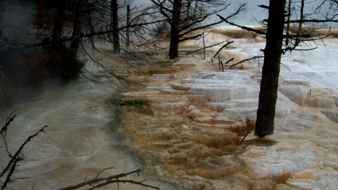 |
The minerals deposited over time have varied so the colour variations
appear. The water was cascading over all three of these colour bands and was
flowing quite fast. It was also still quite hot judging from the steam still
rising. The primary pool is at the top of this picture. |
| There are signs everywhere warning you not to stray from the
boardwalks. Personally none of these pools looked remotely inviting.
Interesting to observe - from a safe distance! | 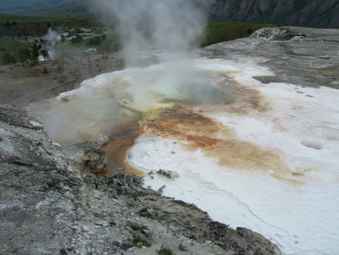 |
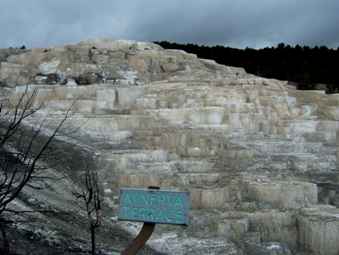 |
This is the largest terrace named 'Minerva' after the Roman goddess
of artists. This is an active feature but water currently flows over a part
of it.
That could change next week for no obvious reason. It looks a bit like
cake-making on a grand scale. |
| This may or may not work for you depending on the quality of your
screen. This was the output of the New Blue Spring, and as it fell over the
edge the carbonates at the top had a very delicate pink tinge. For colour
this was one of the most attractive but is very difficult to portray on
camera without perfect lighting conditions (not the dull grey overcast we
had). |  |
 |
We then moved to the upper terrace where there is a road around the
features (about 1.6 miles). This means no footpaths since Americans don't
walk. However the road wasn't open to RVs (I could see why) so we walked it.
About halfway round we found this "Orange Spring Mound". The water comes from
several vents in the top. The colour again comes from the thermophiles which live in the water. |
| Finally we came to "Angel Terrace" back where we started. This is
a huge feature of which the picture only shows half. It was dormant for many
years in the middle of the century but suddenly became active again in 1985.
So we headed back to the campground again feeling that this had been a
worthwhile expedition. This was the busiest part of the park we had yet been
in (even if most were Asian tourists) and is perhaps a warning for us that
the high season is about to start (despite the weather). |
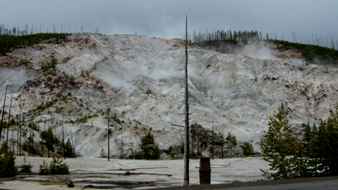 |
|